Bringing Digital Science Deep Inside the Scientific Article: the Elsevier Article of the Future Project
DOI:
https://doi.org/10.18352/lq.8446Keywords:
content innovation, research data, data linking, 3D visualization, content enrichment, text miningAbstract
The ICT revolution of the last decades impacted scientific communication as it has impacted many other forms of communications, changing the way in which articles are delivered and how they can be discovered. However, the impact of ICT on the research itself has been much more profound, introducing digital tools to the way in which researchers gather data, perform analyses, and exchange results. This brought new, digital forms of research output, and disseminating those calls for changes deeply impact the core format of the scientific article.
In 2009, Elsevier introduced the “Article of the Future” project to define an optimal way for the dissemination of science in the digital age, and in this paper we discuss three of its key dimensions. First we discuss interlinking scientific articles and research data stored with domain-specific data repositories — such interlinking is essential to interpret both article and data efficiently and correctly. We then present easy-to-use 3D visualization tools embedded in online articles: a key example of how the digital article format adds value to scientific communication and helps readers to better understand research results. The last topic covered in this paper is automatic enrichment of journal articles through text-mining or other methods. Here we share insights from a recent survey on the question: how can we find a balance between creating valuable contextual links, without sacrificing the high-quality, peer-reviewed status of published articles?
Downloads

Downloads
Published
Issue
Section
License
Copyright (c) 2014 IJsbrand Jan Aalbersberg, Sophia Atzeni, Hylke Koers, Beate Specker, Elena Zudilova-Seinstra

This work is licensed under a Creative Commons Attribution 4.0 International License.





